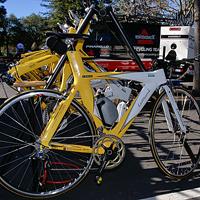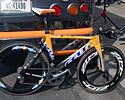
Recently on Cyclingnews.com |
Race Tech: Tour of California, February 18, 2008
TT bikes hit the pavement in California
By James Huang

|
The third running of the Tour of California got off to a picture perfect start in downtown Palo Alto amidst healthy crowds and sunny, warm skies. Although just 3.4 kilometers (2.1 miles) in length, the prologue's relatively flat course meant that teams and riders would be paying especially strong attention to aerodynamics. Wind tunnel testing has long been an integral part of the early season preparations but as teams and riders have become more proficient in the fundamentals of cheating the wind little details are beginning to make more of a difference.
Cables, cables, go away
As it turns out, poor cable housing placement apparently has far more of a detrimental effect than once thought and teams are being much more mindful of cable routing than in years past. Housing has a relatively small frontal area but its round cross-section creates turbulent airflow right at the front end of the bike that can affect the performance of more aerodynamically shaped surfaces behind it.

|
The Slipstream/Chipotle riders left the start house aboard Felt's latest DA frames which were designed from the beginning with significant input from computational fluid dynamics software and wind tunnel test sessions. As a result of some of the knowledge gained there, Felt engineers routed the derailleur and rear brake housings directly into the frame right behind the stem where the air was already 'dirty' from the rider's hands and arms, thus leaving clean air around critical frame regions. According to Slipstream Team Physiologist Allen Lim, sheltered housing consistently save about 1-2 watts in the wind tunnel without the rider aboard. Lim said that adding the rider does wash that result out a bit, but "it still matters."
The concept isn't new (Zipp incorporated the feature in its radical 2001 frame from the early 90's) but other makers have followed suit, such as Trek with its latest Equinox TTX used by the Astana team and even its precursor. On team frames not designed as such, team mechanics made use of zip ties, electrical tape and whatever else would work to tuck the lines around the stem.
That small detail probably didn't make that much of a difference during today's short prologue (the fastest times were under four minutes) but could very well have an impact on Friday's longer time trial stage in Solvang.
Zipp and PowerTap get together

|
Power meters have always been a critical part of Slipstream's training and racing equipment but in the past, riders have either had to ride deep-section rims built around PowerTap hubs during time trial events or simply go without if they opted for discs. Team riders were spotted here at Tour of California with a pair of new Zipp discs, though, both of which were co-developed with PowerTap to directly incorporate the power measuring technology inside a new hub.
One of the wheels is based on the flat-sided Zipp 900 for riders that prefer a stiffer wheel while the other incorporates the company's latest Sub9 shape. Zipp claims its Sub9 is not only the first wheel to yield negative drag (otherwise known as lift) under certain wind tunnel conditions but also delivers a more compliant ride as well.
The Zipp-designed hubs include PowerTap's latest 2.4GHz wireless hardware but use Zipp axles, bearings, and freehub internals. According to Zipp Marketing Manager Andy Paskins, the PowerTap-equipped wheels add only 120g to the standard versions and hubs will be available with ceramic bearings as an upgrade.
Rock Racing goes against the clock with an amalgamation of equipment

|
Rock Racing has been awash with controversy lately and not even its relationships with bicycle and equipment sponsors past and present has been spared. DeRosa emerged as the team's bicycle supplier earlier this season and we expected to see the team's abbreviated roster aboard the Italian company's TT model, the carbon fiber Kron. Instead, we spotted no fewer than three different makes of bikes in the pits prior to the start of the prologue. Half-hearted camouflage efforts did little to hide the distinctive shapes of Scott's Plasma TT and Look's 496 frames and there were no Kron framesets to be seen at all (although they may have pulled them out when we weren't watching). At least one rider took off on an aluminum DeRosa Protos road model fitted with clip-on aero bars.
Michael Ball has managed to strike a wheel sponsorship deal with Cole Products, though, as most team bikes we spotted were equipped as such (along with big green "ROCK RACING" decals, naturally). Still, the team pit area was littered with a wide range of other models (both wheel and otherwise, although we'd never use "wide" in reference to the latter) from manufacturers such as Mavic, Zipp, Lightweight, and Lew Racing.
Photography
For a thumbnail gallery of these images, click here
Images by James Huang/Cyclingnews.com
- Slipstream riders took off out of the start house with two versions of Zipp's new Powertap-equipped disc wheels.
- Zipp will offer its new PowerTap-equipped rear disc in both its new Sub9 shape…
- …as well as a fully flat disc for riders that prefer a stiffer feel.
- Naturally, both wheels get the full dimpled treatment for which Zipp has become well known.
- The prologue for this year's Tour of California was reasonably technical but riders were still sporting 21mm-wide tires in search of more speed.
- Slipstream's Felt DA machines include neatly routed cables that keep them out of clean air.
- Corima carbon-specific brake pads are still a popular choice among the pro peloton.
- The Felt DA of Slipstream rider Dave Zabriskie is ready to go just prior to his start.
- Zabriskie's spare bike was topped by this custom-covered fi'zi:k saddle.
- Several Slipstream guys slapped fi'zi:k's 'extra grip strip' appliqués on their saddles to keep from sliding around.
- Yikes, that's a narrow setup!
- Slipstream kept close eye on rider start times.
- Zabriskie warms up before his start.
- Team CSC will ride Cervélo P3C bikes again this season.
- 3T is a new sponsor for Team CSC and team bikes were fitted with the new Ventus LTD aero bar.
- Not much frontal area to look at here!
- Surprisingly, team Cervélo frames were also fitted with 3T forks instead of the stock Wolf models.
- 3T claims its Funda fork blades offer an aerodynamic advantage thanks to careful shaping.
- The team is also using 3T stems…
- …but not on all of its bikes just yet. Some riders require special sizes which 3T hasn't produced yet. In those cases a sticker will have to do.
- FSA still supplies the team with its cranksets which neatly round out the Dura-Ace drivetrain.
- Team CSC's cables aren't quite as neatly tucked away as on the bikes of Slipstream but there was still some effort put forth to hold them tightly against the stem.
- Start time lists were scattered throughout the team pits.
- Trek claims that the Equinox TTX frames it supplies to Astana are some of the most aerodynamic around, even besting the performance of some perennial favorites.
- The 'grooved' top tube supposedly imparts additional stiffness to the frame.
- Astana is using a mix of rear discs , such as this Lightweight model covered by Bontrager decals supplied by Victory Circle Graphix.
- Bontrager's Aeolus 'triple radius' discs were still in heavy use on the team.
- The Trek Equinox TTX also incorporates very neatly tucked away cables.
- Rock Racing was supposed to be riding DeRosa frames but the only ones we saw were road models fitted with clip-on aero bars.
- Other makes were seen within the Rock Racing warm-up tent including a camouflaged Scott Plasma…
- …and even a Look 496 whose distinctive shapes were easy to identify.
- The Look 496 bears a particularly unique-looking bottom bracket area…
- …but the Look Ergostem and unique fork arrangement were the dead giveaways.
- Electrical tape was liberally applied to conceal the Look logos.
- Hey guys, you missed a spot!
- Rock Racing's Mario Cipollini rode his own make of bike for this year's prologue.
- Cipollini makes his way to the start amidst a throng of fans…
- …and is escorted by a Rock Racing bodyguard!
- Rock Racing has secured Cole Products as its wheel sponsor.
- Even so, there were plenty of non-Cole wheels littered about the team area.
- Rock Racing has only five riders on its start list for the ToC; three had to be pulled since the Puerto investigation was reopened (Tyler Hamilton, Oscar Sevilla, and Santiago Botero, from left to right) and Kyle LeoGrande (far right) was already involved in an open investigation.
- Jelly Belly is sponsored by GT Bicycles but GT doesn't actually offer a TT frame so it apparently procured some frames from elsewhere although we couldn't tell exactly what they really were.
- Mmm… jelly beans!
- Some Jelly Belly riders rode aluminum frames, not carbon ones.
- Kelly Benefit Strategies/Medifast rides LeMond bikes but Lemond doesn't actually offer a TT bike. Instead, riders used earlier generation TTX frames borrowed from Trek.
- SRAM debuted a prototype TT outer chainring on several teams' bikes. It's supposedly stiffer and presumably more aero, but more importantly it provides WAY more room for logos.
- The relatively solid construction is said to be pretty heavy right now but production models will eventually be quite a bit lighter before it's introduced to the public.
- Teams are even using aero bottles these days.
- Trek apparently understood the impact of exposed cables fairly early on as even its previous generation TTX tucked the housing behind the stem where they were sheltered from clean air.
- Team High Road makes an effort to tuck in its cables by virtue of some zip ties.
- Ben Jacques-Maynes' Pinarello Montello FM1 gets the same treatment.

